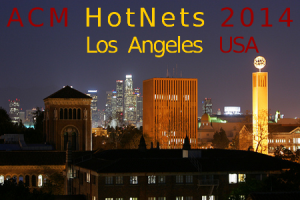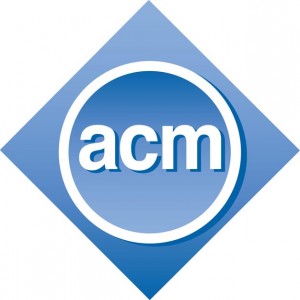HACK: Hierarchical ACKs for Efficient Wireless Medium Utilization WiFi’s physical layer has increased in speed from 802.11b’s 11 Mbps to the Gbps rates of emerging 802.11ac. Despite these gains, WiFi’s inefficient MAC layer limits achievable end-to-end throughput. The culprit is 802.11’s mandatory idle period before each medium acquisition, which has come to dwarf the duration […]
‘Publications’
FUBAR (Flow Utility BAsed Routing) paper accepted for presentation in HotNets’14

FUBAR: Flow Utility BAsed Routing. We present FUBAR, a system that reduces congestion and maximizes the utility of the entire network by installing new routes and changing the traffic load on existing ones. FUBAR works offline to periodically adjust the distribution of traffic on paths. It requires neither changes to end hosts nor precise prior […]
Experimental Evaluation of Multipath TCP Schedulers

Experimental Evaluation of Multipath TCP Schedulers Today many end hosts are equipped with multiple interfaces. These interfaces can be utilized simultaneously by multipath protocols to pool resources of the links in an efficient way while also providing resilience to eventual link failures. However how to schedule the data segments over multiple links is a challenging […]
Virtualizing the Network Edge: Virtual CPE for the datacenter and the PoP
Virtualizing the Network Edge: Virtual CPE for the datacenter and the PoP The telco market is rapidly moving towards an Everything as a Service model, in which the virtualization of traditionally in-the-box network functions is often paired with Software Defined Networking (SDN) tools/technologies and advanced Infrastructure as a Service platforms. Primary area of impact for […]
Poster: Towards Wifi Mobility without Fast Handover

Towards Wifi Mobility without Fast Handover A. Croitoru, D. Niculescu, C. Raiciu. 11th USENIX Symposium on Networked System Design and Implementation. April 2014. Seatle, WA, USA
Multipath TCP

The Internet relies heavily on two protocols. In the network layer, IP (Internet Protocol) provides an unreliable datagram service and ensures that any host can exchange packets with any other host. Since its creation in the 1970s, IP has seen the addition of several features, including multicast, IPsec (IP security), and QoS (quality of service). The latest revision, IPv6 (IP version 6), supports 16-byte addresses.
The second major protocol is TCP (Transmission Control Protocol), which operates in the transport layer and provides a reliable bytestream service on top of IP. TCP has evolved continuously since the first experiments in research networks…
Rethinking Access Networks with High Performance Virtual Software BRASes

Broadband Remote Access Servers (BRASes) play a crucial role in today’s networks, handling all traffic coming from access networks (e.g., DSL traffic), applying operator policies and providing the first IP point in the network. It is perhaps unsurprising then, that these are expensive, proprietary, difficult-to-upgrade boxes…
Trevi: Watering Down Storage Hotspots with Cool Fountain Codes

Datacenter networking has brought high-performance storage systems’ research to the foreground once again. Many modern storage systems are built with commodity hardware and TCP/IP networking to save costs. In this paper, we highlight a group of problems that are present in such storage systems and which are all related to the use of TCP…
Evolving the Internet with Connection Acrobatics

The textbook Internet architecture revolves around the end-to-end principle with smart endpoints and a dumb network, while the actual Internet is far messier, with middleboxes pervasively deployed and affecting end-to-end traffic in many ways. Today’s Internet is fragile as most of the communications are affected by transparent stateful middleboxes deployed along the path…
Towards Minimalistic, Virtualized Content Caches with Minicache

Video comprises the majority of traffic on the Internet today, and most of it is delivered via Content Delivery Networks (CDNs) whose performance depends, to a large extent, on being able to deploy a (sometimes rather large) set of distributed content caches at different networks and geographical locations. Recently, ISPs have started deploying micro datacenters close to customers, giving the possibility to third parties to rent out this equipment…



